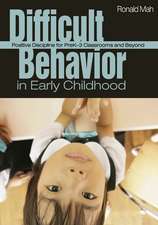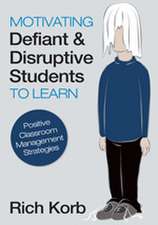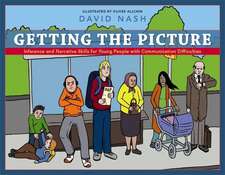A Biological Brain in a Cultural Classroom: Enhancing Cognitive and Social Development Through Collaborative Classroom Management
Autor Robert A. Sylwesteren Limba Engleză Paperback – 24 mar 2003
`Should be required reading for students of education, teachers, and administrators. I would encourage educators for form book study groups to read, study, reflect, and apply what is found here' - Jerry Tollefson, Principal, Marquette Elementary School, Madison
Using research findings from the cognitive neurosciences and a view of the classroom as an ecological system of checks and balances, the author takes the reader into the modern K-12 classroom, reaffirming his belief that students should collaborate with their teachers in classroom management decisions whenever possible.
Preț: 278.58 lei
Nou
Puncte Express: 418
Preț estimativ în valută:
53.31€ • 55.80$ • 44.37£
53.31€ • 55.80$ • 44.37£
Carte tipărită la comandă
Livrare economică 31 martie-14 aprilie
Preluare comenzi: 021 569.72.76
Specificații
ISBN-13: 9780761938118
ISBN-10: 0761938117
Pagini: 192
Dimensiuni: 152 x 229 x 13 mm
Greutate: 0.31 kg
Ediția:Second Edition
Editura: SAGE Publications
Colecția Corwin
Locul publicării:Thousand Oaks, United States
ISBN-10: 0761938117
Pagini: 192
Dimensiuni: 152 x 229 x 13 mm
Greutate: 0.31 kg
Ediția:Second Edition
Editura: SAGE Publications
Colecția Corwin
Locul publicării:Thousand Oaks, United States
Recenzii
"Sylwester’s book offers research, theoretical perspectives, and suggested activities, all of which easily foster reflection on practices related to classroom management, this significant dimension of teaching."
Cuprins
Preface
About the Author
1. The Cultural Foundations of Classroom Management
Democracy and Education
21st-Century Challenges
Collaborative Classroom Management
2. The Biological Foundations of Classroom Management
Three Forms of Biological Inquiry
Key Biological Concepts
Cells and Classrooms
3. The Marvelous Interdependent Bodybrain That Schools Seek to Manage
The Principal Brain Systems
From Jungle to Classroom in Search of a Model
4. Collaboratively Expending Energy: Who's In Charge?
Childbirth, Childhood, and Classrooms
From Potential to Kinetic Energy
Self-Esteem, Impulsivity, and Aggression
Suggested Activities
5. Collaboratively Managing Biological and Cultural Space
Mapping Cognitive, City, and Classroom Space
How Many People Can You Stuff Into a Classroom?
A Classroom Is a Created World Surrounded by a Leaky Wall
Cauliflower in the Classroom
Suggested Activities
6. Collaboratively Managing Biological and Cultural Time
Life Span: Two Developmental Decades
A Year's Curricular Time
A Day in the Life
Suggested Activities
7. Collaboratively Managing Biological and Cultural Movement
Physical Movement
Change as Psychological Movement
Suggested Activities
8. Collaboratively Managing Biological and Cultural Range
Biologically Possible Ranges
Culturally Appropriate Ranges
In the End
References and Supplementary Readings
Index
About the Author
1. The Cultural Foundations of Classroom Management
Democracy and Education
21st-Century Challenges
Collaborative Classroom Management
2. The Biological Foundations of Classroom Management
Three Forms of Biological Inquiry
Key Biological Concepts
Cells and Classrooms
3. The Marvelous Interdependent Bodybrain That Schools Seek to Manage
The Principal Brain Systems
From Jungle to Classroom in Search of a Model
4. Collaboratively Expending Energy: Who's In Charge?
Childbirth, Childhood, and Classrooms
From Potential to Kinetic Energy
Self-Esteem, Impulsivity, and Aggression
Suggested Activities
5. Collaboratively Managing Biological and Cultural Space
Mapping Cognitive, City, and Classroom Space
How Many People Can You Stuff Into a Classroom?
A Classroom Is a Created World Surrounded by a Leaky Wall
Cauliflower in the Classroom
Suggested Activities
6. Collaboratively Managing Biological and Cultural Time
Life Span: Two Developmental Decades
A Year's Curricular Time
A Day in the Life
Suggested Activities
7. Collaboratively Managing Biological and Cultural Movement
Physical Movement
Change as Psychological Movement
Suggested Activities
8. Collaboratively Managing Biological and Cultural Range
Biologically Possible Ranges
Culturally Appropriate Ranges
In the End
References and Supplementary Readings
Index
Notă biografică
Robert Sylwester is an Emeritus Professor of Education at the University of Oregon who focuses on the educational implications of new developments in science and technology. He has written 20 books and curricular programs and 200+ journal articles. His most recent books are The Adolescent Brain: Reaching for Autonomy (2007, Corwin Press) and How to Explain a Brain: An Educator¿s Handbook of Brain Terms and Cognitive Processes (2005, Corwin Press). He received two Distinguished Achievement Awards from The Education Press Association of America for his syntheses of cognitive science research, published in Educational Leadership. He has made 1600+ conference and staff development presentations on educationally significant developments in brain/stress theory and research. Sylwester wrote a monthly column for the Internet journal, Brain Connection, throughout its 2000-2009 existence, and is now a regular contributor to the Information Age Education Newsletter (http://i-a-e.org/).
Descriere
Updated Edition of Best Seller!
Expanding on his immensely popular first edition, Sylwester presents an updated and expanded second edition on the latest biological research.
Expanding on his immensely popular first edition, Sylwester presents an updated and expanded second edition on the latest biological research.













